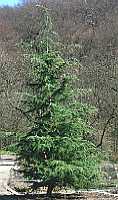| DESCRIPTION: It is an evergreen tree reaching 50 m in height and up to 3 m in diameter. Crown conical when young, with drooping leader and branches drooping at the end, older trees rounded. Branches horizontally arranged, and end of the shoots pendulous. Needles blue-green, about 30 in a cluster, 3-5 cm long, acuminate. Flowers appear in September and October. Cones solitary or in pairs. ovate or barrel-shaped. 7-10 cm long, 5-6 cm wide, rounded at the apex, bluish when young. USE: Is an important timber tree in India and is widely planted as an ornamental in Europe and the western U.S. GROWING PERIOD: Perennial. Can be grown for hardwood with a rotation of 120 years. COMMON NAMES: Himalayan cedar, Deodar, Diar, Deodar, Dedwar, Kelu, Kilar. FURTHER INF: Scientific synonyms: C. libani var. deodara, Pinus deodara. In Afghanistan, it can be found at elevations from 1300 to 3300 m, but is most common at 2000-2900 m. In Europe, it can be found from sea-level. The best trees are found on deep, well-drained soils. High atmospheric moisture is favourable. It is tolerant to shade, but young trees are prone to injury from frosts and cold wind. It is not fire resistant. |
SOURCES
Troup R 1921 pp 1096-1132 [DRA, TEXT, DEP, FER, RAIN, KTMP, TEMP, LIG, LIMITS, USE]
|
